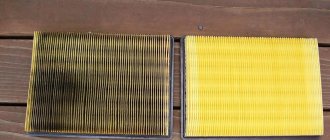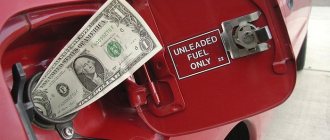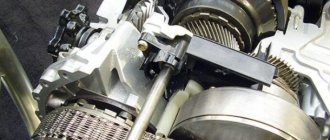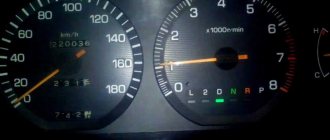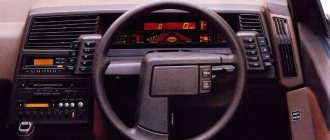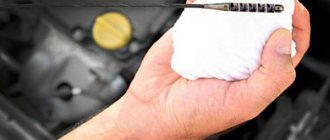02/18/2021 1,131 Consultation with a specialist
Author: Ivan Baranov
Good afternoon I have an F3A automatic transmission. When it's cold it doesn't go backwards or forwards, but when it's hot everything is fine. Please help me figure out the reason! (Vadim)
Vadim, good day. The cause of this problem most likely lies in the consumable transmission fluid. Now we will try to explain in more detail.
[Hide]
Automatic transmission malfunctions: signs, symptoms, causes, error codes
The automatic transmission is subject to significant loads during vehicle operation.
This is the main reason for the occurrence of malfunctions in automatic transmissions, leading to various breakdowns and unpleasant surprises. Modern cars are equipped with very reliable automatic transmissions, designed for harsh conditions and operating conditions. Such equipment significantly reduces the frequency and number of calls to repair shops.
Thus, the latest automatic transmissions, with proper maintenance, carried out on time, and correct operation, are capable of operating about one and a half hundred thousand kilometers. Only after such an impressive mileage will they need major repairs.
Automatic transmission diagnostics is a necessary event that should be carried out regularly in order to identify malfunctions in the mechanism and all kinds of symptoms of a malfunction. It begins with removing and decoding automatic transmission fault codes, followed by troubleshooting with the help of a specialist.
Acceleration dynamics are worse
Why then does a car drive worse in winter and consume more fuel? Firstly, in order for the engine to reach the ideal operating mode described above, when everything functions like a well-played orchestra, it still needs to warm up to operating temperature. And many trips in winter are so short that there is no question of fully warming up the engine.
Typical breakdowns
Most of the malfunctions that appear during the operation of automatic transmissions are of a general nature and are grouped according to principles, which we will consider below in more detail.
Lever links
“Automatic machines” of the previous generation, which are distinguished by a mechanical connection between the transmission and the selector, very often suffer from breakdowns of the lever linkage.
This malfunction does not allow changing transmission operating modes. Full restoration of the unit’s functionality occurs after replacing broken structural elements.
A symptom of the existence of this problem is the difficulty in moving the lever, which eventually stops completely “tightly”. It should be said that some automatic transmissions do not need to be dismantled to repair such a fault, which significantly saves time in fixing it.
Oil
Oil leakage is a very common problem with automatic machines, which manifests itself in the form of lubricant leaks appearing from under the gaskets and seals.
It is easy to detect an automatic transmission malfunction using such noticeable signs, but to do this it is necessary to carry out a visual inspection of the unit using a lift.
If you notice the mentioned symptoms, you should contact the specialists of a specialized service station, who solve such problems without difficulties and delays. The repair procedure consists of changing seals and restoring the volume of transmission lubricant.
Control unit (CU)
Malfunctions in the functioning of this unit also occur quite regularly. They lead to incorrect selection of the automatic transmission speed mode or complete blocking of the transmission. The problem can be solved by replacing control cables and/or control unit modules that have failed.
Valve block (hereinafter referred to as GB)
Malfunctions of this unit are reported less frequently, but they still occur from time to time when, for example, the automatic transmission is not operated correctly, or the car “starts” with unheated units. The symptoms in this case are very typical - shocks, jolts and vibrations of varying intensity.
In modern cars, failures in the operation of the valve body are recorded by on-board automation, followed by an alert being displayed on the computer display. Sometimes the car simply doesn't move.
Torque converter (hereinafter GT)
Failure of this unit is another possible cause of automatic transmission malfunction. In this case, the problems can only be solved by repair, which is usually cheaper than restoring the ECU or valve body.
You should contact a specialist if you notice a disturbance in the car's dynamics, vibrations, rustling and/or knocking. Also one of the symptoms is the presence of metal shavings in the used transmission lubricant.
Causes of automatic transmission malfunction
Problems with the machine can occur due to wear and tear on the elements of this unit. In addition to objective reasons, problems arise due to improper operation of the machine.
Thus, some drivers forget to regularly change the lubricant, thereby causing the unit to overheat, after which its moving parts wear out intensively and break.
The mentioned external signs of problems with the automatic transmission indicate the need to intervene. An exact diagnosis can be made only after a professional diagnosis of the condition of the unit, although a preliminary conclusion can be made by the car owner himself. Let's look at some malfunctions of "machines" with a mention of the reasons for their occurrence.
- The car refuses to move in any gear, and when moving the automatic transmission lever there is no push, indicating that the desired mode has been engaged. There are several reasons explaining this behavior of the vehicle. These include filter clogging, lack of lubrication, damage to GB solenoids/valves, and GT failure. Damage to friction discs, brake bands, piston seals or oil pump gears can also cause similar troubles.
- The vehicle does not move, but a change in the position of the lever is accompanied by a smooth push, indicating the activation of the specified mode. This automatic transmission control malfunction is caused by a lack of lubrication, clogged filter elements or a broken torque converter.
- Reverse gear works, but forward gear does not. Similar difficulties arise for a car enthusiast when the GB valve is damaged or the seal rings, piston cups and/or direct clutch discs (hereinafter referred to as MPH) are broken.
- Only reverse gear does not work. This is how the vehicle behaves due to damage to the brake band piston rod or piston cups.
- The car only drives in the first two gears. This difficulty indicates damage to the drum splines or seals, discs and MPH piston cuffs.
- The car only drives backwards and in the first two gears. This is observed when the valve/solenoid in the GB sticks or breaks.
- The car drives if there is no slope, but slips on slopes, downshifting earlier than expected. This happens when, at the same time, the friction discs of the MPH, as well as its seals and piston cuffs, wear out heavily. But sometimes the cause is a lack of lubrication.
- The vehicle moves when the lever is in the "N" position. A situation indicating that the friction clutch piston is jammed or the discs are stuck together.
- The car slips at the start and during acceleration, after which the “automatic” works without failures. This is the case when slippage of the gearbox shaft occurs due to breakage of the splines in the GT hub. The cause may be damage to the discs and/or piston seals of the MPH.
- Upshifts are activated with a noticeable delay. There is a violation of the throttle valve drive cable adjustment, clogged filter elements and/or a valve wedge in the regulator.
- Clutch slipping occurs when changing gears. This happens when the oil pressure decreases due to incorrect functioning of the valve body solenoids. However, this can happen after the filter elements are clogged.
- The KickDown mode does not work, and when you press the gas sharply, the automatic transmission downshifts. The most obvious is damage to the KickDown mode activator. But this also happens when the pressure sensor is damaged, the cylinder head valves are wedged, or the damper settings are disturbed.
- There is a grinding and humming noise in the differential. These sounds indicate wear of the bearings and gears, and increased play of the pin.
- There are shocks that can be felt when shifting gears. This happens when there is a breakdown of the friction clutch discs or GB valves, as well as when the return spring of the latter is destroyed.
- A drop in main pressure accompanies problems in the form of a wedge of the bypass valve in the MH, the formation of an airbag, a decrease in the amount of lubricant, or clogged solenoids in the GB.
- The engine stalls when changing gears without pressing the gas pedal. This behavior is typical for cars with a broken GT, jammed wheels or GB valves.
- The car drives only with a cold gearbox, after warming it up it stops and does not respond to the positions of the automatic transmission lever. This occurs when the operation of worn friction clutch discs is accompanied by the use of low-viscosity transmission lubricant. Similar problems are caused by a decrease in lubricant pressure in the line.
- The vehicle is difficult to accelerate. This behavior of the vehicle is provoked by deformation of the blades on the reactor or turbine wheel of the GT.
- Slipping and jerking of the car while driving is explained by damage to the overrunning clutch.
- The car does not drive, but the main pressure is normal. This is typical for vehicles whose GT hub splines are too worn.
- The car does not drive, and the main pressure is reduced or absent. This usually happens due to a broken spline on the oil pump shaft or GT stator.
- A clanging sound is heard from the automatic transmission when the engine is idling. This unpleasant noise indicates damage to the friction clutch discs.
Trouble-shooting
An automatic transmission is a complex unit that must be repaired by experienced specialists. But some problems that arise in the “machine” during operation of the car can still be solved independently. It is these decisions that will be discussed further.
- The car moves when the lever is on o or the signal on the car’s instrument panel does not correctly display the actual position of the automatic transmission lever. The reason for this is a failure of the correct settings of the gear shift mechanism or damage to its structural elements. The issue can be resolved by identifying and replacing broken components and then adjusting the equipment to meet the requirements of the vehicle operating regulations.
- The vehicle’s power unit starts when the gearshift lever is placed in positions other than “N” and “P”. Most likely, this state of affairs is caused by problems in the gear shift system, which were mentioned above. It is also possible that the start switch integrated into the box may malfunction. The situation can be corrected by adjusting the operation of the start activator.
- Oil leaking from the box. Reasons: arbitrary loosening of fasteners securing individual structural elements or breakage of sealing rings for lubrication. In the first case, it is enough to tighten the bolts and nuts, and in the second, replace the gaskets and seals with fresh new analogues.
- Noise in the gearbox, spontaneous or difficult gear shifting, as well as the vehicle’s refusal to move, regardless of the positioning of the lever, indicate a lack of lubrication in the unit. Measuring the lubricant level and replenishing it will help correct the situation.
- When it is impossible to switch to a lower gear without pressing the gas pedal, it means that the settings are faulty or the throttle actuator components are broken. Here, diagnostics are needed, which will make it possible to determine the damage, with further replacement of structural elements or adjustment of settings
Dear readers, if you liked this material, subscribe to our channel and stay updated on new articles on the
Vostok-Avto service station
Source
Why does the automatic transmission kick?
A gearbox is a complex mechanism consisting of a huge number of parts. Some components break or wear out. Most often, the driver feels kicks while driving in Drive mode. There are a number of reasons that lead to this problem, but one of them is a lack of oil in the transmission. When twitching begins, it is recommended to first check the amount of lubricant in the automatic transmission.
Changing the oil and filter does not always help get rid of box kicks. Sometimes it is possible to find out the cause only through a complete diagnosis. The service center will help identify problems and prevent complete transmission breakdown.
Often there are problems with the torque converter or valve body. If the problem lies with them, it is enough to replace the solenoids or buy a completely new unit. This type of breakdown is typical for cars with mileage of more than 150,000 km. The main cause of kicks remains untimely oil changes, which causes increased friction and wear of parts.
Also, insufficient oil quality can lead to kicks.
Conclusion
In spring, the optimal combination of still cool air and the complete absence of excess resistance to movement will be achieved.
In spring, the optimal combination of still cool air and the complete absence of excess resistance to movement will be achieved.
Perhaps the optimal times of year from the point of view of maximum engine thrust and minimum resistance forces are spring and autumn, when the tires are summer, there is no snow, and the engine pulls like a beast in the cold. Well, spring is coming! We wait!
- A car blanket, heated wipers and specialized auto chemicals will help you enjoy winter to the fullest.
4 reasons why your car accelerates worse in winter
A car with an automatic transmission does not drive: causes and troubleshooting
Thanks to technological progress, the automatic transmission has replaced the manual transmission. She is increasingly winning fans even among former opponents. Smooth gear shifting makes it possible to extend the life of the vehicle by relieving the load on the engine and chassis. A manual transmission is simpler and has less trouble identifying faults than an automatic transmission. If a car with an automatic transmission does not move forward or backward, then this is a big problem. This article is devoted to diagnosing automatic transmission faults and repairing them.
All car systems are interconnected, thanks to the automatic transmission, some engine malfunctions are invisible. Before you begin repairing the automatic transmission, you need to make sure that the engine and all its systems are in good working order, including the vehicle's electrical wiring.
The automatic transmission does not move forward or backward - options for solving the problem
What to do if a car with an automatic transmission does not drive when cold? In most cases, the owner of the vehicle may encounter this problem in winter. As a rule, this is due to the fact that the existing oil in the box has thickened. Thick fuel has a negative impact on the functioning of vehicles. In particular, the oil pump begins to experience heavy loads, and proper compression of the friction discs is not ensured. The result of this is that the car slips. That is why, for preventive purposes, vehicles should be warmed up before moving.
When the clutch friction discs wear out, there is often no third gear when changing gears. However, these manifestations are a consequence of the fact that the piston cuff has lost its properties. All worn out elements must be replaced with similar auto parts.
If the car does not move, but the gears are working, it is advisable to check the brake band. Also, these manifestations are typical if the sealing collars on the coupling have ruptured.
The reason that vehicles have become worse at accelerating is low fuel and lubricant pressure in the automatic transmission lines. The use of low-quality fuel contributes to a reduction in the service life of friction clutches.
If a car with an automatic transmission does not move when you engage the gear, you need to check the oil filter. In parallel with this, the following may be noted:
- gearbox overheating,
- the appearance of a characteristic mechanical sound.
As a result of overheating, the control unit may lose its operating properties.
Damage to the brake band piston rod can be indicated by the fact that the vehicle is moving forward and does not move in reverse gear.
If the automatic transmission does not run hot, the oil and seals on the cones must be checked. Damaged seals and seals must be replaced.
If the car only drives backwards, it is worth checking the speed sensor and the oil level in the gearbox. If there is a problem in the transmission control unit, the car cannot drive uphill or move while descending (the gearbox may be blocked).
Thus, there are many symptoms indicating that it is necessary to check the condition of the automatic transmission, for example, the car does not move when the gear is engaged. If a vehicle equipped with this box starts but goes backwards, this is a consequence of the fact that there may be a mechanical failure or a malfunction in the electronics. Replacing transmission parts that have exhausted their service life allows you to solve such a problem as the automatic transmission does not move either forward or backward.
Possible reasons
If any problems arise with the automatic transmission or electronics, a light will light up on the display indicating an automatic transmission malfunction. You should immediately perform diagnostics to determine the cause of the malfunction and eliminate it. If you do not respond to malfunctions in a timely manner, then, instead of minor repairs, there may be a need for major repairs or replacement of the automatic transmission.
Diagnostics
Every time you leave a garage or parking lot, you should inspect the place where the car was parked. Particular attention should be paid to oil stains and their color: if they are red or orange, then these are the colors of the transmission fluid. The reason for their appearance should be found out.
It is necessary to constantly monitor the oil level, color and consistency using a dipstick. The grease should be translucent and red. If there is darkening or foreign particles are present, the oil requires replacement. Usually the lubricant is changed every 15 thousand mileage, but at least once a year. A sign of a faulty automatic transmission is a dark color and a burning smell.
Determining oil quality by color
If there are electronics on the car, follow an external inspection using an on-board computer or a special scanner to obtain fault codes. They are written to the control unit's memory while the car is driving. Then the serviceability of switches, sensors, wiring, and connectors is checked.
If it is not possible to determine the fault in a stationary vehicle, then you can conduct a test drive. At the same time, the operation of the engine, gearbox, and control system is diagnosed. The proper operation of an automatic transmission depends on the health of the engine, so it should be given no less attention than the gearbox.
Typical faults
During a test drive, you should pay attention to noises in the engine and automatic transmission; they may indicate the following malfunctions:
- a whistling sound reminiscent of a siren indicates a malfunction of the torque converter;
- a continuous howling sound that changes with engine speed on a car at rest indicates insufficient oil level, air getting into the oil pump, damage to the oil pump gears, or incorrect position of the gears;
- a buzzing sound that increases with increasing engine speed appears when the oil seals wear out or the valve spool, which regulates oil pressure, vibrates;
- continuous rattling when driving at low speeds indicates a malfunction of the turbine pump or torque converter spring;
- if there is a problem in the engine flywheel, a rattling sound appears, which disappears when the gearbox is switched to the “neutral” position and at low speeds;
- the appearance of an extraneous sound when shifting only one gear means that some planetary gear of this gear is faulty;
- Noise that occurs when shifting gears and does not disappear when switching on others indicates wear of the liners and support bearings.
Automatic transmission handle
Malfunctions of the automatic transmission can be divided into groups:
- malfunction in the gearbox control unit;
- breakdown in the torque converter;
- faults in automatic transmission hydraulics;
- problems in the mechanical part of the machine.
Below we will look at the main breakdowns that put the gearbox into emergency mode.
Often a car with an automatic transmission does not drive when cold and begins to slip. Most often this happens in winter, the oil is too thick, the oil pump does not provide the necessary compression of the friction discs. The car does not move, it slips, which means there is no traction between the discs, they turn and rub against each other. This removes the abrasive material on the discs that provides traction. Therefore, a car with an automatic transmission should always be warmed up before driving.
If the car does not move forward, stands still, and the first, second and reverse gears are in order, the third is missing, then the cause may be wear of the friction discs of the direct or forward clutch, oil sealing rings, or piston cup. Worn parts should be replaced.
If the car does not drive, but the gears are all working, then the friction layer on the brake band may be worn out, the cuffs on the clutch may rupture, or the piston rod of the brake band may be broken.
The cause of slipping may be faults in the mechanical part of the box: gears, pump, clutches, bushings. If the splines in the torque converter are faulty, the car may slip at the beginning of the movement, and then drives as usual. If there is no pressure in the automatic transmission valve body, gears shift with a delay or shock.
If the car drives only at third speed and accelerates slowly, this is due to a decrease in oil pressure in the lines of the automatic transmission: there is not enough lubrication, the pressure regulator is faulty, the gearbox solenoids are faulty. It is possible that aluminum shavings have gotten into the solenoids; they should be removed and cleaned.
If letters are displayed on the instrument panel that do not correspond to the gear engaged, or are not displayed at all, the switch position sensor or gear selector may be faulty.
What to do
If the decrease in dynamics is not critical, it is not accompanied by extraneous sounds when the engine is running, error signals do not appear on the dashboard, which means there are no problems in the mechanisms. The reason is a loss of power before it warms up completely. In this case, you only need to change the operating mode: abandon the shortest trips, reduce speed and revs, and closely monitor the selected gearbox speed.
On a note! Prolonged heating on site will not correct the situation; on the contrary, it leads to rapid wear of parts.
Before the winter season, it is important to carry out the necessary maintenance. Sometimes the car practically does not accelerate due to the solidification of oils in various systems. This is due to the wrong choice of liquid type or poor quality of the product. Therefore, it is better to buy oils with a reserve of heat resistance, and also change them in advance if the production resource is already close to critical.
Sometimes a more serious breakdown can be determined not only in the service, but also visually. If you press the gas, the speed increases, but the car does not move, it is worth inspecting the filters and spark plugs. The latter may require routine manual cleaning or quick replacement. You can also check the wires for damage. If the car reacts poorly to the gas and does not accelerate, the reason may be the clutch or the engine itself. The second will manifest itself with noticeable vibrations even at idle. This can only be fixed in the service.
In winter, the car's dynamics deteriorate sharply. Ruts, snow drifts, and ice prevent you from moving quickly and accelerating. All mechanisms require long-term warm-up, only after which they can reach their technical capacity. However, problems with dynamics can be caused by low-quality oil or gasoline, or breakdowns in the main systems of the car. Therefore, before the difficult winter season, it is recommended to carry out unscheduled maintenance.
